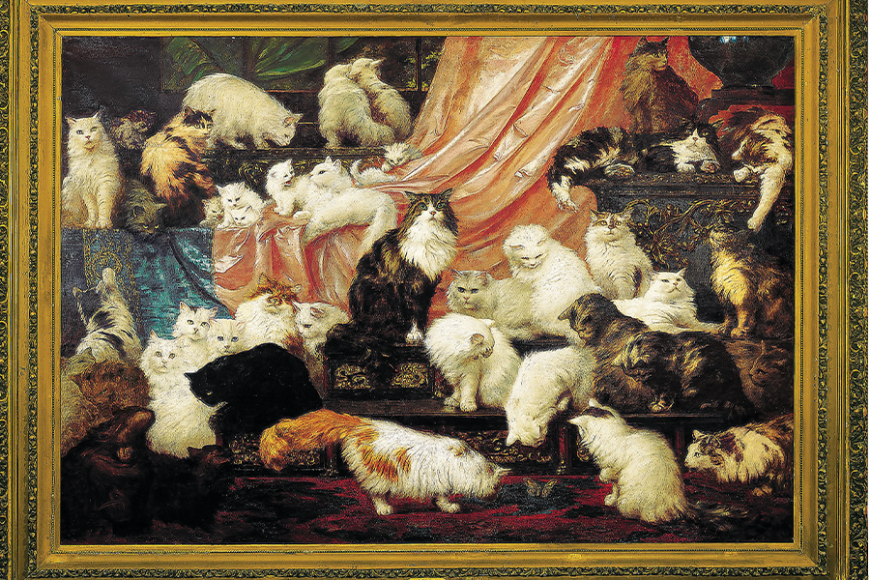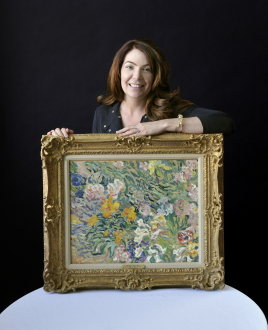Portraits, the likeness or image of a person, are among the most treasured and widely collected forms of art. There are famous museums devoted exclusively to portraits. The likenesses of beloved family members are prized possessions in many homes. Public buildings often feature portraits of notables.
A special category of portraiture that captures our hearts and imaginations is animal portraits. Sometimes a portrait is made because of the subject’s fame, for example a prize-winning racehorse. More often, however, an animal is painted because the artist, or the animal’s owner, is fascinated by its beauty, charm or personality.
We all know that cats are always going viral. (They are the unofficial mascots of the internet, the single largest subject of online images.) But felines also top the list of painted and paintable critters. Cats taking a catnap, grooming themselves, caring for their kittens or curled in their companion animal’s arms or lap have been a favorite subject for artists for generations. (It goes without saying that to a cat, the “companion animal” is the two-legged person who fills the food dish.)
It’s well-known that cats were highly regarded in ancient Egypt, even worshiped in the form of the cat goddess Bastet. The Egyptians thought that cats brought good luck and symbolized justice, fertility and power. And from the ancient world until modern times, cats everywhere have been valued for their usefulness in controlling such dangerous pests as disease-carrying, grain-thieving mice and rats.
Cat portraiture began to increase as cats grew in popularity as household pets. They were treasured for being soft and cuddlesome, clean and quiet, yet at the same time independent and less demanding of attention and space than dogs, their major rivals as domestic companions.
The heyday of painted depictions of cats was the 19th century. Industrialization created a newly prosperous middle class that could afford to feed nonworking animals and could also afford to purchase cat pictures and even to commission portraits of favorite felines. Love of nature and of sentimentality, leading Victorian concepts, combined to make animal paintings enormously popular. That popularity continues today.
Stephen Fletcher, executive vice president of Skinner Inc. and director of the Americana department, is a longtime collector of cat portraits. As often happens, Steve’s extensive collection started almost by accident, with the gift of a cat portrait from a friend. Then, as he was leaving a small antique show, Fletcher saw an irresistible 1830s painting of two tiger cats. His collection began to grow.
Like these cats, many examples of feline folk art are an inheritance from the Victorian era. Fletcher notes that such informal depictions are often based on close observation of and affection for such expressive, endearing and often mischievous creatures. A bonus for collectors is that appealing examples can be found at flea markets and garage sales as well as at high-end auction houses and can often be acquired for modest sums.
Fascination with felines as subject matter is not limited to amateur painters and little-known folk artists. John Singer Sargent, Gustave Courbet, Pierre Renoir and Paul Gauguin are among the many masters of 19th century art who painted cats. More recent renowned painters/cat enthusiasts include Pablo Picasso, Salvador Dalí and Andy Warhol.
Like felines themselves, cat portraits transcend borders. In addition to the many American, French and Spanish artists who portrayed cats, several outstanding English illustrators — including John Tenniel, Arthur Rackham and Lewis Wain — were ailurophiles.
Dutch painters, especially noted for genre scenes of everyday life, also frequently made cats prominent features of their domestic interiors. And Asian artists from Ming Zhen to Kuniyoshi and Hiroshige II studied cats closely and portrayed them with humor and affection.
People often ask, “How can I begin to collect art?” Fletcher and other professionals in the auction world, who are exposed to the broadest possible range of antiques and collectibles, answer “Buy something that resonates with you, moves you.”
For many people that something is a portrait of a cat, the familiar yet mysterious animal that has been called a canvas for human emotions. A cat portrait, whether humorous, sentimental, playful, or simply beautiful, may be the next best thing to sharing a home with one’s own personal feline.
For more, contact Katie at kwhittle@skinnerinc.com or 212-787-1114.


